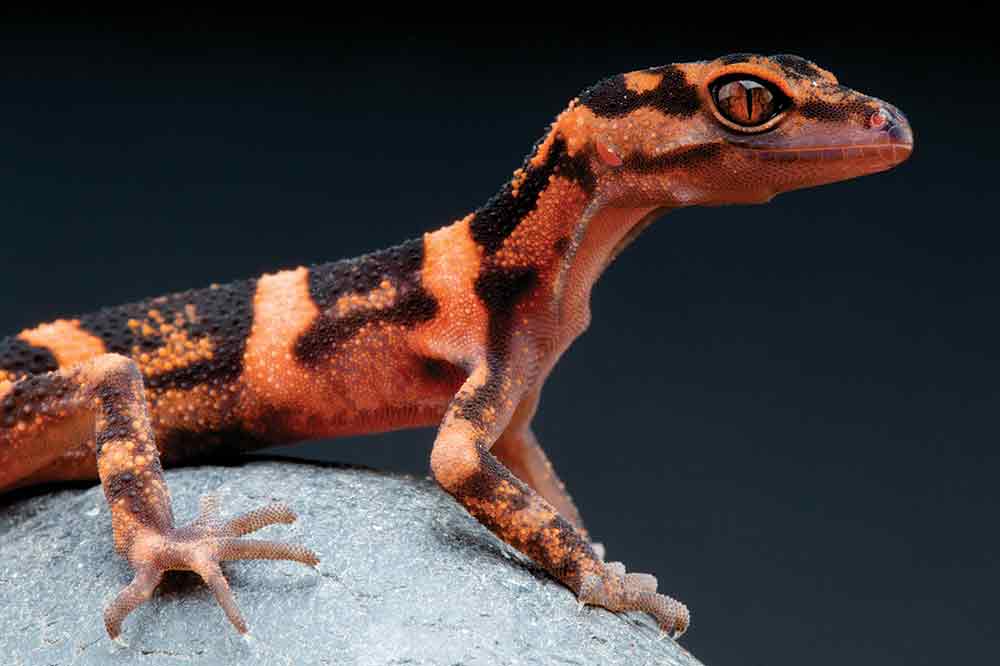For those who enjoy leopard and fat-tail geckos, Goniurosaurus offer an exciting new horizon.
Eublepharidae are often collectively referred to as the eyelash geckos and contain genera throughout many of the warmer regions of the world. The leopard gecko (Eublepharius macularis) is certainly the most well-known of the group, however there are other genera and species that enjoy a following with reptile keepers. Cave geckos of the genus Goniurosaurus have been steadily rising in popularity over the years. Superficially similar to the popular leopard gecko, Goniurosaurus are smaller in overall size, often very colorful, and easy to care for as long as their requirements are met.
Cave Gecko Description
Goniurosaurus range in size an average of 9 inches (22.8 cm), depending on the species. Hatchlings tend to display sharply contrasting banding patterns of various coloration. The banding remains in adulthood to some degree in most species, however intensity and supplemental coloration will vary. Depending on the species, adult coloration can range from relatively drab to the base color offset by spectacular reds, yellows, pink, orange, as well as black and white speckling.
Cave Gecko Range
Goniurosaurus are native to Asia, with various species found in parts of China, Vietnam, and Japan. Many species have restricted ranges.
Do Goniurosaurus Live in Caves?
The popular name obviously suggests that Goniurosaurus are cave dwellers. This is only true to a degree. The term cave gecko is a popular western term for Goniurosaurus. In Asia, the genus is often referred to as tiger geckos. Preferring moist and cool habitats, Goniurosaurus typically inhabit forest floors, often near water, in the crevices of limestone and granite rock formations, as well as around the entrances to caves. Cave geckos are semi-arboreal in nature and can easily scale rock walls and other rough surfaces. They are not able to adhere to glass, plastic, and other smooth surfaces.
Conservation and History with Reptilekeepers
Many Goniurosaurus species are under threat of population decline in the wild. Much of this is due to occupying relatively narrow habitat ranges in combination with habitat loss. Collection for the pet trade has also been a factor. In China, cave geckos are also harvested for use in traditional medicine.

Goniurosaurus hainanensis. Photo by Vladimira Pufflerova/Shutterstock
Various species of cave geckos have been sporadically available as wild-caught individuals since approximately the mid-1990s. In 2019, 13 Goniurosaurus species were classified under Appendix 2 of CITES, which limits the trade in field collected specimens. Fortunately, cave geckos had developed an appreciation and following.
Dedicated reptilekeepers and breeders began breeding many of the most sought-after species. Several are now bred on a regular basis and others can generally be found with some patience and diligent searching. This article will focus on husbandry with special mention made to several species likely to be encountered in the United States at the time of this writing.
Out of the above listed species, only G. hainanensis is available on a fairly consistent basis. Other species that show up with less frequency include G. bawanglingensis, G. lichenfelderi, G. kuroiwae, G. orientalis, and G. splendens. There are a handful of breeders working with a few others such as G. yamashinae and G. yingdeensis.
Ideal Goniurosaurus Enclosure
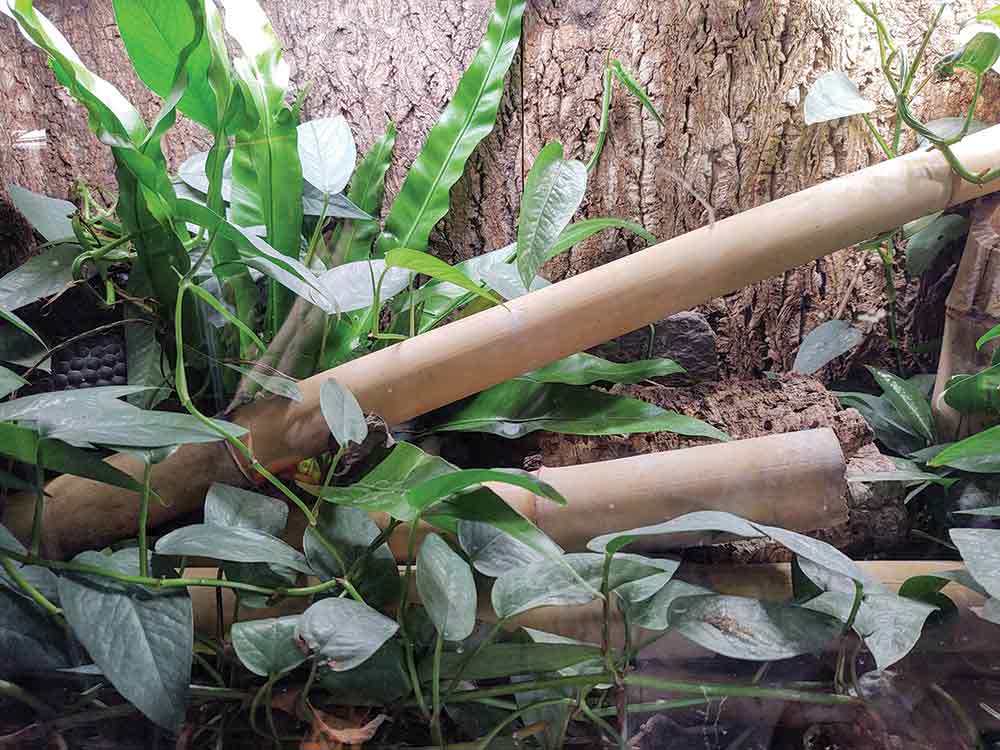
Plenty of hiding and climbing structures make an ideal enclosure. Photo by Foster Reves
As long as base criteria are met, housing requirements for Goniurosaurus can be as simple or complex as the keeper desires. In my experience, cave geckos seem to do equally well in simple, plastic shoebox style containers as well as elaborate planted vivaria. Commercial enclosures specifically designed for reptiles, aquariums, and plastic storage tubs can all be used successfully. Despite being unable to climb smooth surfaces, all enclosures should remain secure, especially if household pets and younger children are present. Aquariums should include a screen cover. Plastic tubs must have numerous holes drilled in the lid as well through the upper sides to allow for cross ventilation.
I recommend an enclosure footprint no smaller than a standard 20-gallon long aquarium, 30 inches (76.2 cm) by 12 inches (30.48 cm) by 12 inches (30.48 cm) for a pair or trio. Goniurosaurus will make use of climbing structures however, with this said, floor space is more important than height.
Screen-covered aquariums with a base footprint of 36 by 18 inches (31.4 by 45.7 cm) as well as large plastic totes. Properly sized, reptile specific enclosures from the major manufacturers are also ideal.
Ideal Goniurosaurus Substrate
Substrate can range from simple paper towels to one of the many commercial vivarium mixes specifically designed for tropical forest animals. If paper towels or other dry, non-soil substrates are used then a sizeable humidity chamber is essential. Some keepers use ground, additive free orchid bark as a substrate along with a proper humidity chamber. I often use a homemade mix consisting of two parts high quality, fertilizer-free topsoil combined with one-part coco fiber and one- part sand. This mix holds humidity well and easily allows for a moisture gradient within the enclosure. Standard potting mixes should be avoided due to the usual addition of perlite and fertilizers. In addition, Goniurosaurus are not desert dwellers so a sand-only substrate is not suitable for use.
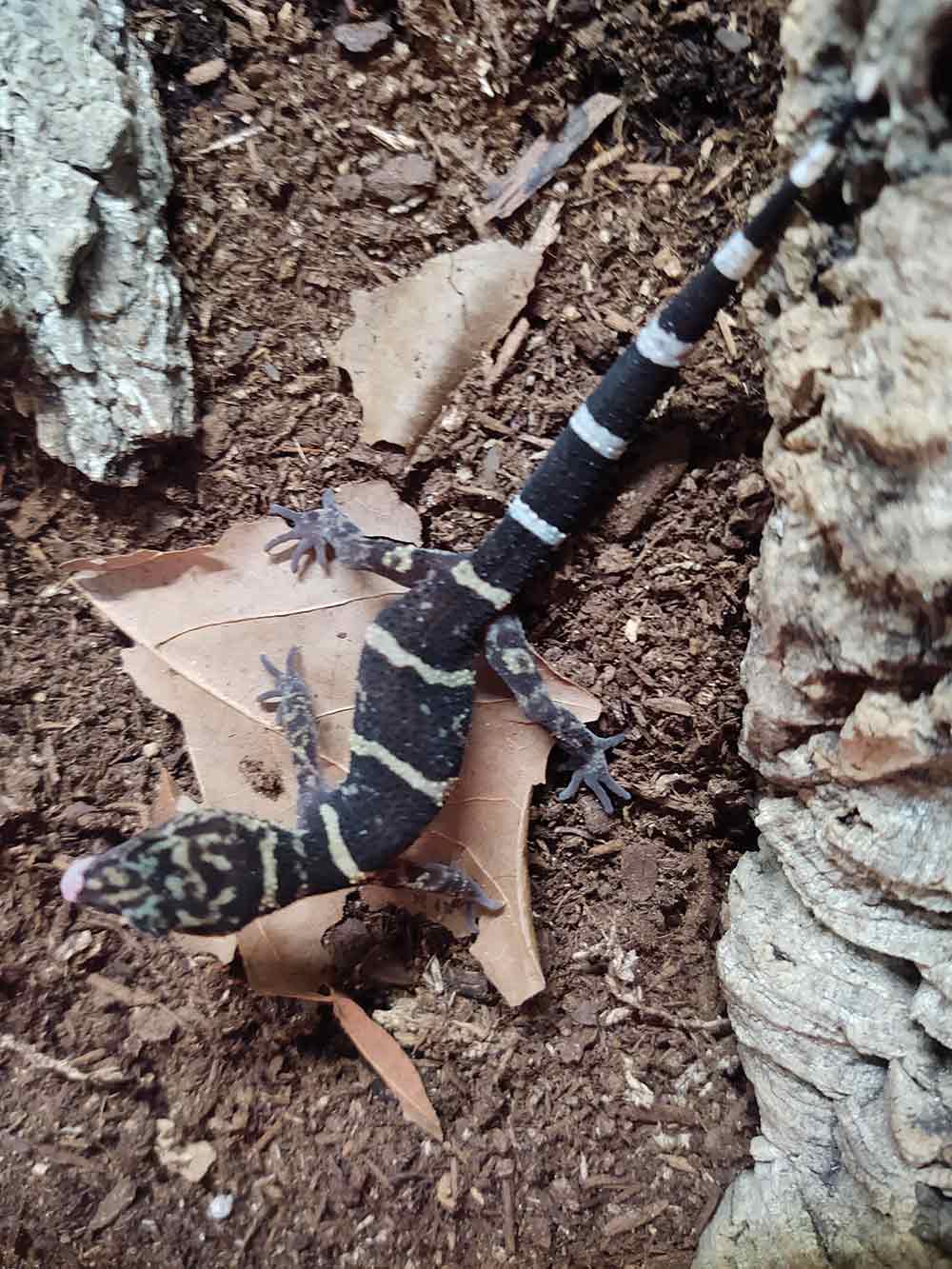
Goniurosaurus yamashinae yearling on an orchid bark bedding. Photo by Foster Reves
Ideal Humidity for Cave Geckos
Cave geckos require access to humid micro-environments. Keep the humidity levels around 55 to 65 percent. If kept too dry, then shedding problems will become an issue. In a soil-based vivarium this is easily accommodated by keeping a portion of the substrate consistently moist. Dry areas must also be provided so that a moisture gradient is achieved. Cork bark flats and other shelters can then be placed randomly throughout the enclosure, allowing individuals to choose as needed.
If a basic enclosure design is utilized, soil can still be used effectively as outlined above. If soil is not used, then a humidity chamber will be required. A humidity chamber is essentially a plastic box or other container that has a hole cut in one of the sides that is large enough to allow an individual lizard easy access but not so large so that the substrate will dry quickly. Substrate can consist of any of the aforementioned soils, as well as long fibered sphagnum moss available at most nurseries and garden centers. Commercial humidity containers are also available. Substrate should be kept moist but not wet. Moisture levels should be checked during routine maintenance and water added as necessary. Whichever style of container is used, it should be large enough so that the geckos have enough room to move about freely. Daily misting also aides in elevating humidity levels.
Enclosure Additions
Goniurosaurus are not truly arboreal, however they will make use of climbing structures in captivity. Cork bark branches secured at an angle will often be used, both for climbing during the night and resting in the hollows during the day. In one of my naturalistic vivaria, G. kuroiwae regularly cling vertically to the cork background, taking shelter under the vining plants.
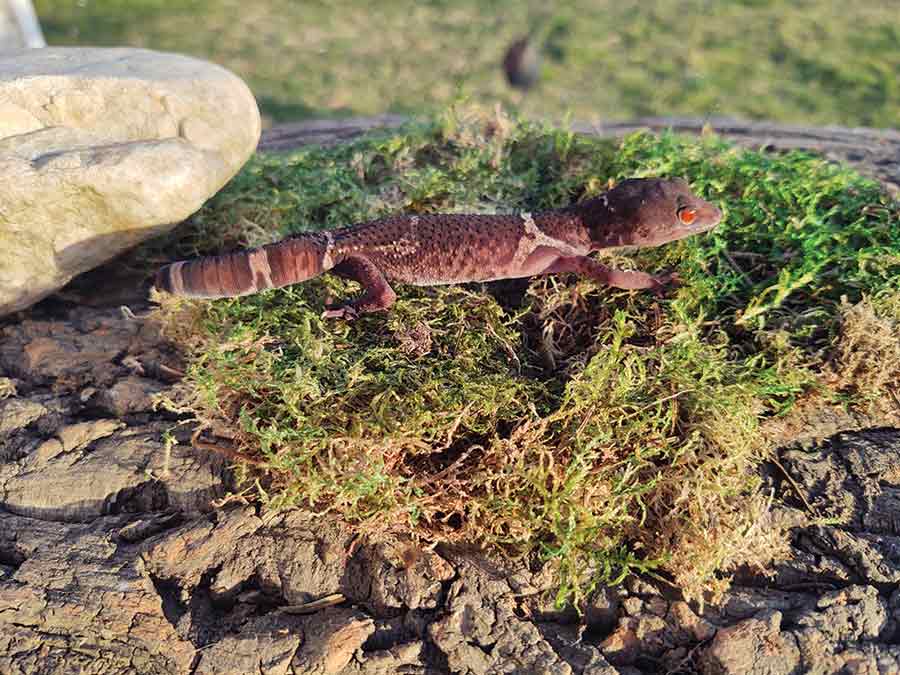
Goniurosaurus hainanesis on cork bark. Photo by Foster Reves.
Some European keepers will utilize small slabs of slate, resting at a slight angle against one of the enclosure sides. This mimics a cave-like shelter. I have experimented with using similar structures with varying degrees of success. Some individuals will frequently use these crevices for hiding while others seem to ignore them. Extreme caution should be exercised when using rocks of any sort in animal enclosures. If not properly secured even the slightest shift can seriously injure or kill a vivarium resident. Bamboo can make an aesthetically appealing furnishing. The smooth surface makes it difficult to climb. The geckos will often use the hollows as shelter.
Do Cave Geckos Require Shelters and Hides?
Cave geckos require shelters in their enclosures in order to feel secure. Cork bark flats make excellent shelters and enhance the appearance of naturalistic vivaria. If aesthetic appeal is not a concern, then simple shelters can be made from plastic or clay plant saucers with an entrance created. There are a number of commercial shelters on the market which are also suitable.
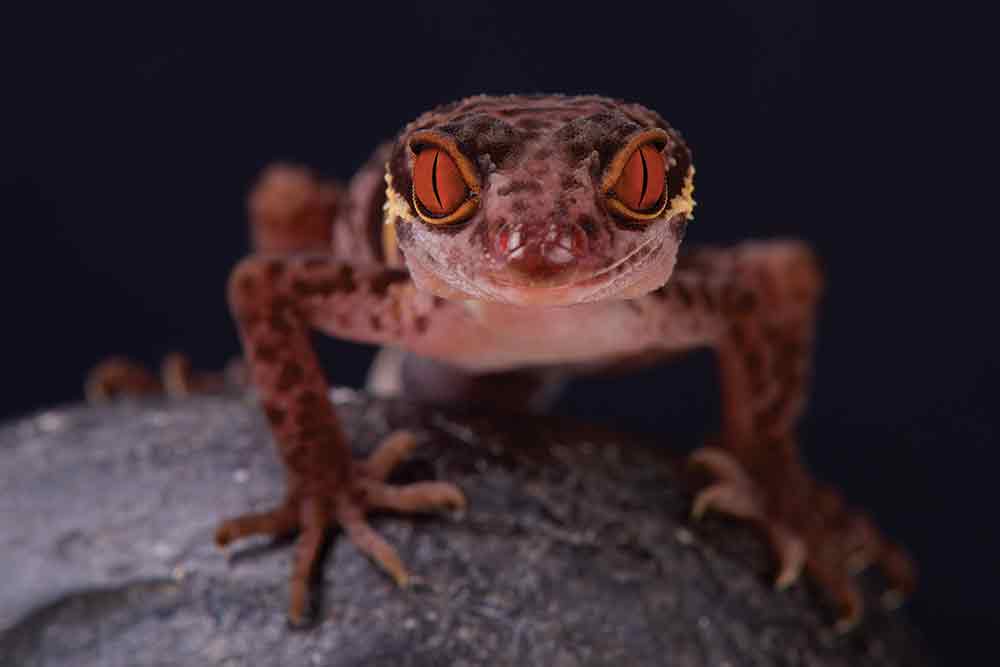
Goniurosaurus hainensis. Photo by reptiles4all/Shutterstock
Vivaria Plants
In naturalistic vivaria, there are many suitable plant species that can be used with Goniurosaurus. Philodendron and Epipremnum species are classic vivarium plants. Both genera tend to grow well under a variety of lighting conditions, often requiring occasional pruning. It is well beyond the scope of this article to focus on all potential suitable plants that could be used. Any species utilized should either be produced specifically for vivarium use or repotted with roots rinsed of potting additives.
Cave Gecko Lighting
Since cave geckos are nocturnal by nature and do not bask, no supplemental UV lighting is required. The author uses daylight LED lights for planted vivariums in order to both benefit the plants as well as provide a more natural circadian rhythm. No supplemental lighting is utilized for Goniurosaurus kept in plastic storage tubs.

An enclosure for a juvenile cave gecko. Photo by Foster Reves
Cave Gecko Temperature
Goniurosaurus as a whole hail from temperate micro-environments. If maintained at average room temperatures, no supplemental heating is required. More to the point, it is important to not maintain excessively warm temperatures as this can be detrimental to the health of the lizards. My herp room is kept at average room temperature (72 degrees Fahrenheit, 22.2 degrees Celsius). The temperature drops a few degrees in the winter and rises several degrees in the summer.
Cave Gecko Diet
Goniurosaurus are insectivorous and will accept a variety of prey. Typical feeder insects are eagerly accepted. Excessively large prey should be avoided. Full grown dubia roaches (Blaptica dubia) are too big for most species to tackle with ease, however the young will be eagerly accepted. Adult field crickets (Acheta domestica) can generally be consumed however half-grown individuals, approximately 0.5 inches (1.8 cm) work much better. Large superworms (Zophobas morio) can be consumed by adults with relative ease, however only several per feeding should be offered in order to prevent excessive weight gain. Mealworms (Tenebrio molitor), waxworms (Achroia grisella and Galleria mellonella), small tomato hornworms (Manduca quinquemaculata), and other commercially available species can be used to add variety to the diet.
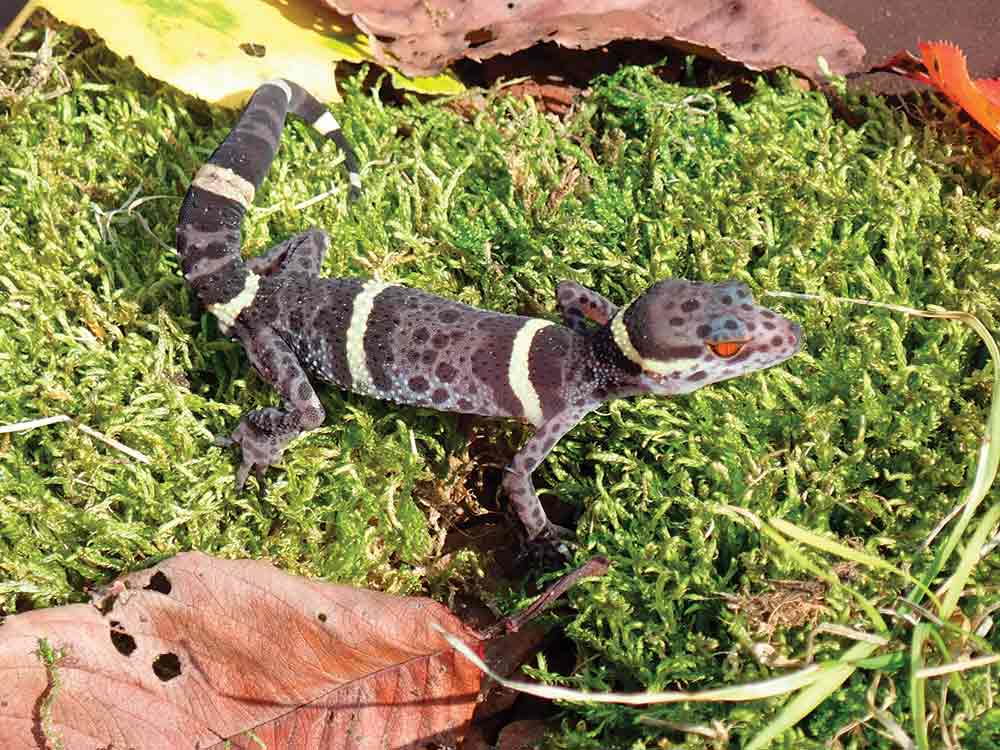
Juvenile G.hainanensis. Photo by Foster Reves
No single prey item should ever be fed exclusively. Waxworms in particular, are fattening and can lead to obesity if over-fed. On more than one occasion, I have discovered well started youngsters that had managed to escape detection in naturalistic vivaria. These enclosures all utilized common isopods (Porcelio scaber) to aide in cleaning waste matter so it is presumed that Goniurosaurus will also accept isopods as well. In soil-based enclosures it is best to offer everything except for crickets in shallow feeding dishes with a vitamin and mineral supplement. Roaches and the various larvae mentioned may burrow into the substrate if not initially consumed.
I feed adult Goniurosaurus three times a week during breeding season and twice a week for most of the rest of the year. During winter cold snaps when the ambient room temperature dips below 70 degrees Fahrenheit (21.1 degrees Celsius), food is withheld altogether.
Supplements
I use a 3:1 ratio of calcium and vitamin D3 powder mixed with a multivitamin powder. Crickets are dusted prior to feeding. A small amount of supplement should be placed in feeding dishes for insects offered in this manner. There are multiple brands of commercial reptile vitamins available on the market.
Water
Water is provided in a shallow dish in all enclosures. Water is changed every several days or sooner if needed.
Handling and Temperament
As a whole, Goniurosaurus are flighty when compared to leopard geckos. Some individuals may tolerate short periods of handling if the situation demands. They will generally walk along an arm but can and will jump quickly if startled. Handling should be kept to a bare minimum since doing so only serves to stress the animal. Like so many other lizards, males will not tolerate each other in the same vivaria. Multiple females can be housed together along with a single male.
Sexing and Reproduction
Mature animals are easily sexed by looking at the ventral surface. Males have a pronounced bulge at the base of the tail when compared to females. In captivity Goniurosaurus tend to reproduce in the spring and summer. In general, two eggs are laid at a time. Depending on the species, up to four clutches can be laid in a season. Incubation times may vary somewhat with species. Young hatch after approximately 60 to 70 days. I incubate eggs at room temperature in a ventilated container with a commercial hatching medium. The medium should be kept moist but not wet. The medium should be monitored frequently, and distilled water can be added as needed to prevent drying. After hatching, the young are kept either individually or in pairs in low, flat commercial plastic enclosures designed for small reptiles, amphibians, and invertebrates.
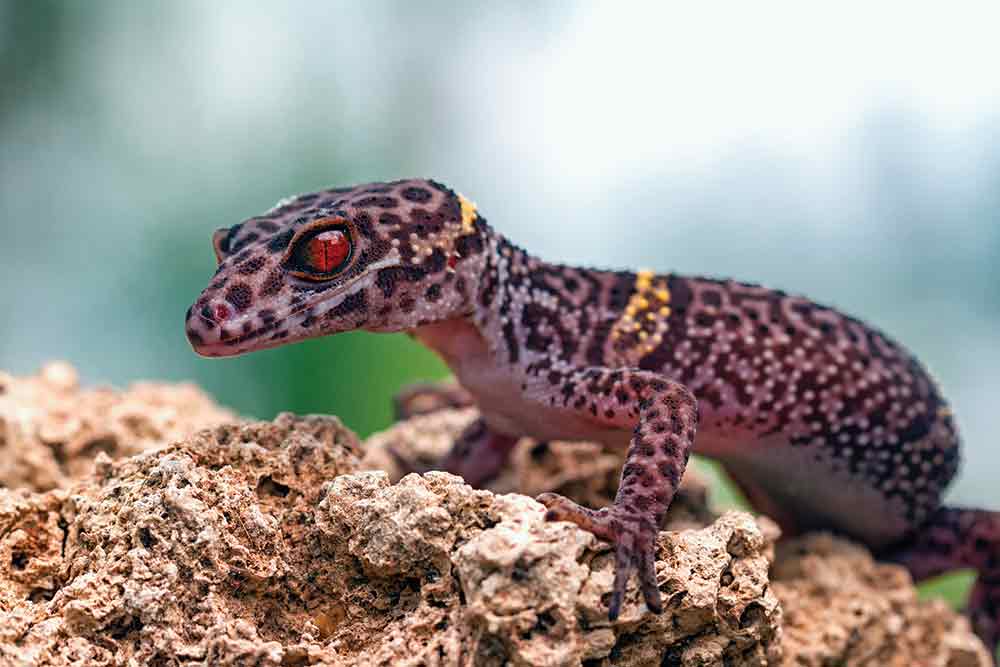
Goniurosaurus lichtenfelderi. Photo by kefca/Shutterstock
Paper towels are used as an initial substrate. In my experience, paper towels make it easier to monitor overall health including food intake and defecation. It is critical however to provide a humidity chamber. After several weeks when all individuals are eating well and showing no signs of ill health, the paper towels are replaced by a shallow soil substrate, which is kept moist at one end. All other cage furnishings are the same as outlined for adults. Hatchlings are initially offered small food items such as pinhead crickets, flightless fruitflies (Drosophila hyedi), and bean beetles (Callosobruchus maculatus). All food items are dusted with supplement. Hatchlings are offered food daily and as size increases feeding frequency is decreased accordingly. Hatchlings will grow to young adults in approximately two years. If more than one hatchling is maintained in the same rearing container then it is important to monitor for potential infighting as they grow. Males should be separated.
Conclusion
There is always more knowledge to be had regarding cave gecko husbandry, particularly with the lesser kept species. For those who enjoy leopard and fat-tail geckos, Goniurosaurus offer an exciting new horizon. Bold coloration and ease of care make cave geckos an ideal choice for those wishing to explore keeping a new species.
Foster Reves is a SW Virginia based hobbiyst and breeder of various herps, invertebrates, and fish. Foster lives with his wife and two children and works as an RN at the Salem VA Medical Center. In addition Foster also enjoys freelance writing on ocassion. Foster can be reached at foster_reves@yahoo.com for any questions or comments regarding this article.

